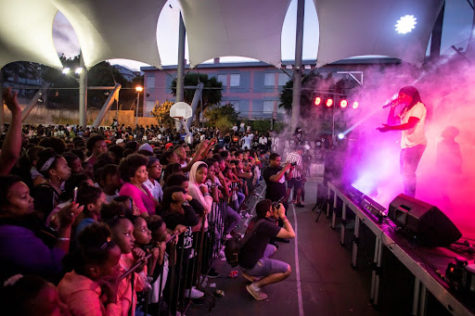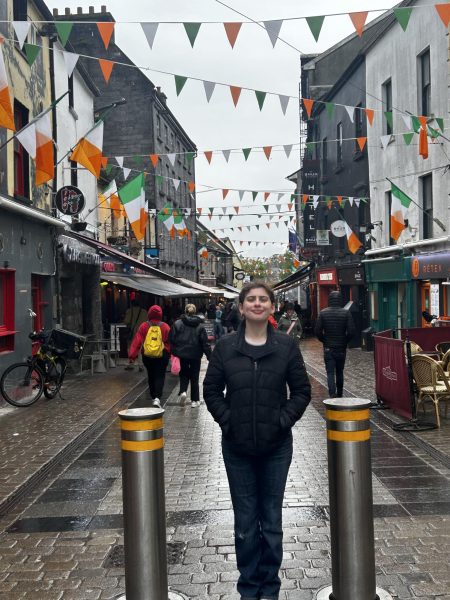The Story of Cova da Moura, Lisbon’s Urban Island
A Cape Verdean enclave on the outskirts of Lisbon, Portugal, Cova da Moura has been notorious for its precarious housing and rampant crime. Now, local organizations, poverty tourism, and local journalism start-ups are redefining the neighborhood.

While it is commonly thought that Cova da Moura was “created” in 1974, the neighborhood only started to gain population in that period. Before, the area was home to more indigenous residents and was perceived as a wasteland by industrialists.
In Cova da Moura, life is far from simple.
A little less than ten kilometers away from the Lisbon metropolitan area, the Portuguese neighborhood is woven with a careful balance of tumultuous change and self-management. Brimming with vigor and a sense of African ambience, it is full of order and disorder. At the same time, its residents have ceaselessly beat back against a myriad of social issues, grasping onto their heritage while reshaping the processes of urban development.
Although the name Cova da Moura has no official translation, it is synonymous with slum life and urban poverty. A quick TripAdvisor search for “Cova da Moura,” initially, yields an ancient monument site in Noia, Spain. Scroll a bit further down, and the neighborhood enters the picture. A 2013 Lisbon Travel Forum poses the question: “Cova da Moura. Anything worth seeing there?”
The replies? “Good luck.” “It’s a bad neighborhood.” “Definitely a place to avoid. There’s nothing special to see.”
This perception of Cova da Moura, however, is lopsided — its oversimplification disregards the complexity and genius loci of the community. The streets of Cova da Moura are made up of vibrance and a diverse cultural tapestry in which travel and immigrant stories play a prominent role. When these stories are told, Kriolu (Cape Verdean Creole) and Portuguese go hand in hand.
Entering a Cova alleyway means entering a vessel of the local aesthetic: from street art to pulsating ballads, Cova da Moura is reinventing itself as an intersection of old and new, of departures and arrivals. Yet it is anything but binary.
Spatial Segregation
Most famously associated with Brazil and the slums of Rio de Janeiro, the term favela is used to describe working-class shantytowns and has become connected to violence, poverty, and a rising drug trade.
Across the Atlantic Ocean, situated on one of Lisbon’s seven hills, stands Cova da Moura: a Portuguese favela of roughly 7,000 residents. Over two-thirds of the community population is from Cape Verde, a small archipelago off the coast of West Africa.
“Only a highway and a forest park separate it from the city center, but it could be an ocean away,” wrote journalist Sebastian Bouknight in a 2018 photo essay. “It’s like this piece of land doesn’t belong to Portugal.”
In the 1970s, Lisbon experienced a shift in its population: following a reinstatement of democracy after decades of fascist rule, thousands of immigrants, or retornados (returnees), moved to Lisbon’s periphery from former Portuguese colonies in Africa and other rural Portuguese regions.
These migrations largely took place in suburban areas with low socioeconomic profiles — most workers found jobs in civil construction, and women, in particular, were concentrated in domestic service. Due to a housing shortage and the process of decolonization, an increasing number of immigrants began to illegally occupy public and private lands.
Thus, in 1974, Cova da Moura was formed. In the years prior, Cova was primarily known as a wasteland, until its inhabitants built makeshift housing in the vacant area to gain closer proximity to factories and railway transportation. As time went on, factors such as the expansion of the civil construction industry and Lisbon’s hosting of Expo ’98 caused a high demand for immigrant labor. Despite this rapid growth, the original issues of illegal housing and poverty persisted, and as a result, underground crime like the drug trade took shape.

Illegal settlements have drastic effects, not only for the community at large but also for the individual household. When residents have no proof of property ownership or official title deeds, it becomes incredibly difficult to sell or repair dilapidated buildings and settle land disputes.
With the progression of illegal housing, however, came a tireless fight for better living and working conditions. In 1978, Godelieve “Lieve” Meersschaert moved to Portugal from Belgium as a young psychologist, with the initial goal of advocating for fairer wages in the textile industry. After she settled down in Cova da Moura and met her husband, Eduardo Pontes, the pair established ‘Moinho da Juventude,’ or the Windmill of the Youth community center. From developing youth work initiatives to everyday centers like daycare and libraries, Moinho increased the quality of life for Cova residents and revitalized Cape Verdean traditions in daily activities, such as singing during work and strumming the violão (acoustic guitar) after dinner.
Moinho and Lieve Meersschaert are still active today, but have faced challenges since day one. For one, as Moinho grew, other associations with similar aims began competing for the same resources, turning what was originally a shared drive for improvement into sociopolitical tension. Notably, while community organizations engaged in a new conflict over competition versus cooperation, younger reformers spawned a new vehicle of change: research and science. By investigating multiple disciplines — from anthropology to architecture — college students and professors have produced a different lens of awareness and created public policy recommendations for Cova da Moura.
But these projects are just the beginning, and a much more deep-rooted problem remains: the stigma around Cova da Moura and its residents.
Looking past the numbers, stigma is a lot more abstract. The view of Cova da Moura held by Meersschaert and other residents is starkly different from that of urban planners and the Portuguese government. Cova da Moura was, essentially, invisible to the Portuguese government for the first quarter of the century it was built; it was not until land value rose that local municipalities took an interest in improving the neighborhood.
This motivation was quickly reversed due to pressure from landowners, who saw the more valuable land as an opportunity to push for government compensation. Concurrently, while investors saw an increase in the rent gap and profit margins, Cova’s residents became more susceptible to gentrification and divestment. Municipal leaders designated Cova da Moura as an area in need of recovery, and in 2001, proposed to demolish approximately 80% of the district.
The original plan never materialized, due to local resistance and the rise of a new initiative. Moinho and its neighbor associations joined to create a resistance committee, collecting resident signatures and denouncing such territorialization as a means for those in power to capitalize on the changing status quo.
In 2007, João Ferrão, the former Secretary of State for Cities and Planning, advanced the Initiative for Critical Neighborhoods, which included a European Economic Area grant that allocated €3.8 million to legalize land ownership, rehabilitate basic infrastructure, and strengthen local entrepreneurship. However, the 2008 Financial Crisis led to a global shutdown, ultimately preventing the implementation of these changes. Even today, demolition is still uncertain.
Meanwhile, Cova’s residents have owned their “right to the city,” a term coined by French sociologist Henri Lefebvre in 1968. This right encompasses individual liberties; it rejects social exclusion and advocates for a collective reclamation of the urban space by marginalized groups. In Lefebvre’s words, it refers “to individualization in socialization, to habitat and to inhabit.”
Afrodiasporic Creativity
Cova da Moura, in reality, is a place of radiating culture. Known as ‘Kova M’ to its residents, the neighborhood is home to mostly Cape Verdeans, along with smaller numbers of Angolans and Guineans.
In an effort to both beautify public spaces and renew Cova’s culture, artists have created “open-air galleries,” such as the KOVARTJAM Graffiti Festival. Street art of Black activists like Nelson Mandela, Martin Luther King Jr., and Tupac Shakur can be found at nearly every corner, permanently inspiring today’s generation of artists and musicians.

In Cova da Moura, African music signifies cultural power. Older musicians perform morna, a slow type of folk music that provides a Cape Verdean spin on the blues and Portuguese fado, while younger artists promote the more upbeat funana and batuque genres.
Rap discusses heavier social challenges, primarily in response to the institutional racism and police violence that run rampant in Cova da Moura. In 2019, for example, eight police officers were convicted of crimes including bodily harm and kidnapping against Black youth. However, the ruling only served as a small victory — as a whole, racism and discrimination are still not enough to win criminal prosecution in Portugal. The normalization of racial prejudice has disincentivized victims from taking legal action, and when violence is brought to court, the legal system often perpetuates the same kind of injustice.
LBC Souljah is one ‘veteran’ rapper who has incorporated activism into his music, repudiating structural oppression and empowering the Cova community. In the track “Amilcar,” he collaborates with fellow rapper Chullage to pay homage to Amilcar Cabral, a Cape Verdean and Bissau-Guinean author and diplomat who was at the forefront of the liberation movements in his countries of origin. Independently, in works such as “Tudu Pobri é Um Soldjah,” Souljah celebrates the diversity of the neighborhood and describes local residents as soldiers against the backdrop of negative reputation and coverage: he sings, “…Undocumented immigrants; they are soldiers… The young studying; they are soldiers/We are all soldiers in this cruel reality.”
Moinho da Juventude continues to be a pillar in the community in terms of Cova’s culture. Meersschaert and the association’s volunteers have created free recording studios for music and film, making Moinho particularly impactful at a time when local Kriolu rappers did not receive mainstream recruitment or scouting.
From the Kova M Festival to Kola San Jon, community-wide events unite different cultures and bring together singers, rappers, and dancers alike. Specifically, Kola San Jon, or the Party of St. John, has been a cornerstone of Cova da Moura since 1992: celebrated at the end of every June, it originates from the islands of Santo Antão, São Vicente, and São Nicolau in Cape Verde. Appealing to a wide scope of generations, Kola San Jon enables younger children to learn about their ancestral roots while allowing older generations to engage with customs from their homelands.

These festivals further exemplify Cova da Moura’s “right to the city,” shaping the cultural changes in Lisbon at large. Bottom-up creativity is often more powerful than large artistic institutions like centers or museums; a 2020 study by Carlos Garrido Castellano and Otávio Raposo details that these informal, community-based initiatives have the ability to uniquely challenge structural racism, racialized subjects, and cultural commodification in art.
Every year, the festivities grow bigger. As David Harvey argues in his famous 2008 essay, the right to the city is far larger than equal access to urban resources or surface-level equity policies. Instead, it is “the right to change ourselves by changing the city.” Cova da Moura’s cultural embrace has done just that.
Linguistic Empowerment: Mensagem de Lisboa
The Portuguese language, despite its reach, can be exclusionary. The lingua franca in Cova da Moura’s streets is not Portuguese, but rather Kriolu, the native Portuguese-based Creole of Cape Verdeans and their diaspora.
In Language and Social Identity, John J. Gumperz discussed the all-encompassing nature of language — how it is not only a means of communication or a measure of technical ability, but reinforces sociopolitical understanding and affects access to power structures.
As a result, Cova da Moura is not just spatially segregated from Lisbon, but socially as well. When Portuguese is the mainstream, many people are thus unable to fully understand and engage in public discourse — inevitably, some words get lost in translation. Restricting ethnic minorities to resources and opportunities through language only serves as another barrier to social mobility and draws an invisible color line through Lisbon.
To counteract this “othering,” Mensagem de Lisboa, a Lisbon-based journalism start-up, has started covering news in Creole. The project aims to increase representation on three fronts: to provide linguistic accommodations to immigrants, cover issues affecting the Creole-speaking population in the media, and advocate for more minority journalists in the industry.
In the age of globalization, Creole is being rethought as a strategy for progress: originally created as a bridge between colonized societies and colonizer regimes, it has transformed to include variations of simple vehicular language and engender a greater affinity between cultures. By diverting from conventional media in this way, Mensagem works to create a more informed citizenry and provide a platform for marginalized voices, spreading discourse between different groups in the process and uncovering stories that may otherwise go untold.
“Mensagem de Lisboa is all about inclusive journalism, community journalism,” said Karyna Gomes, a journalist at Mensagem and musician of Bissau-Guinean and Cape Verdean origin. “They think of the whole Lisbon, not only of Lisbon of the white and of privileged. In Mensagem, everyone has a space.”
Mensagem publishes in Portuguese, Creole, and English, and recent stories range from Timorese youth immigration and Brazilian LGBTQ+ refugees to the lack of Lisbon streets named after women. Read more here.
Changing Mindsets
It is famously said of Cova da Moura that taxi drivers do not want to enter the area after dark for a multitude of fears — from the drug trade to police raids, Cova has held the position as “one of Europe’s most dangerous slums.”
Tourism, however, is repainting the perception of the neighborhood, where daytime travelers have stopped by impoverished areas like Cova da Moura for around five euros per tour. More specifically known as “poverty tourism,” this trend has a mutual benefit: tourists are able to become more aware of lifestyles different from their own, while the residents receive a boost to the local economy.

Poverty tourism can also be unethical if managed irresponsibly, and has been subject to much controversy over the years. When tourism profits from poverty, money often goes to wealthy tourism operators and rarely reaches the people. The nature of slum tours also has the tendency to treat local residents as animals in cages, where tourists are told to “look, but don’t get too close.” Especially when tours involve watching residents complete daily, mundane tasks, many see the concept as something commodifying and even exploitative.
Although poverty tourism receives criticism for glamorizing the bleak daily realities for the poor, balancing the benefits and harms of the practice is ultimately up to the way in which tour guides present the area and tourists take in their surroundings. Fortunately, in Cova da Moura, poverty tourism is executed more ethically. Local residents help organize tours, and tourists are encouraged to eat at family-owned restaurants. Overall, the outside perspective of Cova is gradually changing; Cape Verdean, Bissau-Guinean, and Angolan cultures — and their intersection, despite once being countries rarely anyone knew about — are becoming more and more well-known.
Cova da Moura is marked by a kind of abandonment, but also a kind of unfathomable resilience. It is an urban island — not physically cut off from the rest of the city but so spatially and socially segregated that its people have created a separate identity for themselves.
“People can say whatever they want about Cova da Moura, but I will only leave this place when I’m dead,” said 75-year-old Evaristo Marques, who was born in Cape Verde but has lived in Cova da Moura for years.
So is it dangerous? At night, probably. Is it complicated? Definitely. But it is distinctly its own. Cova da Moura is a story of exceptional grit, enduring the test of time and emerging as a uniquely close-knit community. More importantly, it is a place of simultaneity, where histories intersect, ideas bloom, and cultures coexist.
Entering a Cova alleyway means entering a vessel of the local aesthetic: from street art to pulsating ballads, Cova da Moura is reinventing itself as an intersection of old and new, of departures and arrivals.
Charlotte Zhou is an Editor-in-Chief for ‘The Science Survey.’ In addition to writing and editing articles, she constructs the online crossword and...










